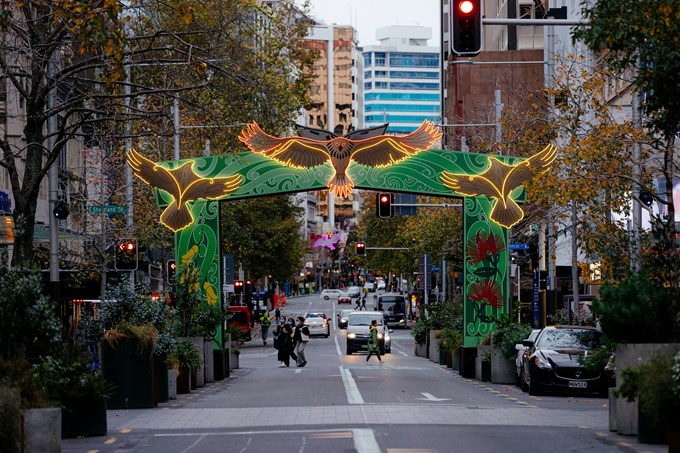Tūrama
From the karanga of Hape welcoming early waka voyagers to the open invitation from Ngāti Whātua Ōrākei to William Hobson to establish the settlement of Auckland in 1840, to becoming the beating heart of contemporary Tāmaki Makaurau, the Waihorotiu valley has always been a place renowned for the extension of manaakitanga, for welcoming and extending hospitality to visitors, to guests and to ourselves.
The ancient citadels Te Ngahuwera, Te Rerengaoraiti and Te Horo Roa standing above, the bountiful Wai o Horotiu river flowing along the valley floor to meet Te Waitematā, the abundant ngahere of the valley teeming with life and song, the generations upon generations of footprints left by Mana Whenua over the millenia; all part of a native and natural landscape now lost beneath the modern city centre’s urban form, removed from our sight.
But not from our memories. Or our future.
Tūrama is an open invitation to all of Tāmaki Makaurau to revisit and re-imagine the Waihorotiu valley. You will celebrate art works by icons of Māori art and design, meet the manu (birds) of this place, and come face to face with a 9-metre-high representation of resident kaitiaki Horotiu.
Prepare to be amazed at the celebration of light, form, scale and life that has been developed for Tūrama by the creative team of Graham Tipene (Ngāti Whātua Ōrākei, Ngāti Kahu, Ngāti Hine, Ngāti Haua, Ngāti Manu), Ataahua Papa (Ngāti Korokī Kahukura, Ngāti Mahuta) and Angus Muir Design.
Te Kaunihera o Tāmaki Makaurau (Auckland Council) and Ngāti Whātua Ōrākei are proud to bring Tūrama and the Waihorotiu valley to life as part of Matariki ki te Manawa, for all of Tāmaki Makaurau to enjoy.
Te Wehenga
The role of waharoa (gateways) in Māori architectural tradition is to physically demarcate boundary, to mark the junction of realms, states, domains and/or space, a transition point where something changes, where one leaves something behind and progresses into something/somewhere different.
Te Wehenga is a contemporary waharoa that has been located at this point to physically embody and mark this notion of transition, and to remind us of the native and natural ecologies of place – natural, social and cultural. This location at the junction of Shortland and Queen Streets marks a key point on the original coastline, where whenua (land) met moana (sea), where Wai o Horotiu met Waitematā, the junction of wai māori and waitai, and all of the systems and tensions present in each of those relationships.
Standing in this original landscape position, Te Wehenga strips away the concrete, the bustle and noise of the contemporary city centre to recognise the domains of two atua Māori, Tangaroa and Tāne Mahuta, tamariki of Papatūānuku and Ranginui the primordial parents. Artwork from Graham Tipene powerfully invokes these atua and characteristics of their respective domains. Tāne Mahuta welcomes you into his domain as you head up Queen Street, and Tangaroa welcomes you into his realm as you head northwards towards Waitematā.
Te Wehenga also reminds us of the need to consider our place in the world, Tāmaki Makaurau as a holistic entity in all of our thinking to ensure the wellbeing of place and community:
Ki uta, ki tai, te hononga e kore e whati, he puna oranga mō ngā tāngata katoa
The enduring relationship of land and sea, a wellspring of wellbeing for us all
If you look around you, you will notice two significant artworks by Fred Graham (Ngāti Korokī Kahukura)- Kaitiaki II and Te Waka Taumata o Horotiu - which also speak to the native cultural landscape that exists in this location.
Te Wehenga is a collaboration between Graham Tipene (Ngāti Whātua Ōrākei, Ngāti Kahu, Ngāti Hine, Ngāti Haua, Ngāti Manu), Ataahua Papa (Ngāti Korokī Kahukura, Ngāti Mahuta) and Angus Muir Design.
Kawau Tikitiki
The Kawau Tikitiki (cormorant/shag) is a significant manu (bird) for a number of iwi and hapū whose heartlands are located across the full breadth of Aotearoa. This bird is revered by ngāi Māori for its characteristics and character; its constancy of purpose, resolute nature, its tenacity, its slowness to move but speed in acting. For all of these attributes, the Kawau is often used in traditional oratory as metaphor for a Chief or a distinguished visitor.
A famous tauparapara of Ngāti Whātua Ōrākei refers to Kawau Tikitiki in this way:
Tirohia atu te Pane-o-Horoiwi
Whakapukepuke whakatikitiki ki waho rā
He Tikitiki he Kawau he Kawau he Tikitiki
Ka heke ki Tahuna Torea
He Tikitiki he Kawau he Tikitiki
Ka eke ka eke ki te Waitematā
Tihei Mauri Ora!
Look to the forehead of Horoiwi, to Achilles Point
Rising majestically there
It is a visiting shag
Alighted on the sandbank at Tahuna Torea, the sandbank of the oyster catcher
A distinguished visitor has come to the Waitematā
It is the breath of life!
You may note that the head of the artwork above you looks to the east towards Takaparawha at Ōrākei, the ancestral heartland of Ngāti Whātua Ōrākei, acknowledging the mana and role of Ngāti Whātua Ōrākei in the city centre.


